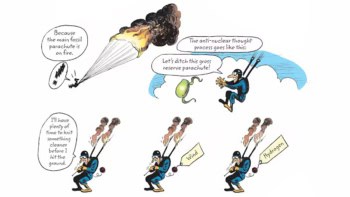
The travel skills of Inuit peoples have mitigated against the changes in environmental conditions wrought by climate change. That’s according to researchers who studied communities in the eastern Canadian Arctic and found that trail access was affected much less than expected.
“Previous studies on Arctic transportation and climate change do not take into consideration different types of trail users,” says James Ford of the University of Leeds, UK. “We found that an understanding of how trail conditions are affected by changing conditions, as well as a knowledge of alternative routes and a well-developed skillset, such as being adept with snowmobile or recognizing dangerous ice conditions, had a greater impact in determining whether trails were safe to use – more so than the change in travel conditions due to climate.”
Inuit peoples in this region use semi-permanent trails on sea-ice, rivers and frozen ground to travel between settlements, to cultural sites and for traditional hunting, fishing and gathering. The trails are vulnerable to sea-ice melt and flooding but it had been difficult to pin down whether climate change has affected local people’s ability to use them.
Ford and colleagues found that highly skilled travellers were able to use the trails more than twice as often as those who were less skilled. The study accounted for trail users’ skill level and risk tolerance. For example, trail users with a high risk-tolerance and good skills were assigned a maximum ice coverage threshold for boat access of 50%, while lower-skilled boat users looking for low risk were set a cut-off of 10% ice coverage. Accidents in small boats, such as sinking or people being thrown overboard, are more frequent in high ice conditions.
The team examined changes in conditions between 1985 and 2016. Mean monthly temperatures increased by an average of more than 2 °C. Overall trail access increased by roughly one or two days. Reduced sea-ice trail access in autumn and winter was offset by better access to land and water trails in spring and summer because of improved visibility and wind conditions.
Travellers with high skill can expect roughly 100 more days suitable for travel each year than travellers with lesser skills, the researchers found.
“While climate models can provide a bigger picture of the overall effects of climate change, it can be harder to determine how environmental variables are affecting specific activities within different communities in affected regions,” says Ford. “The study highlights how the close involvement of the people in question is essential to understanding how the ongoing changes to the environment will affect specific activities of different groups.”
While the skill set of the Inuit community may mitigate the effects of climate change on travel conditions for now, Ford adds, there is no doubt that the warming in the Arctic has detrimental effects.
“The shrinking sea-ice and shifts in seasonal temperatures are a serious threat, particularly to the region’s native species and ecology which form an essential part of the Inuit community’s tradition and culture,” he says. “And while the effects of climate change to date on trail access were not totally what we expected, communities are very concerned about what future change may mean.”
Ford and colleagues reported the study in Nature Climate Change.
- This article is based on a press release by the University of Leeds, UK.



